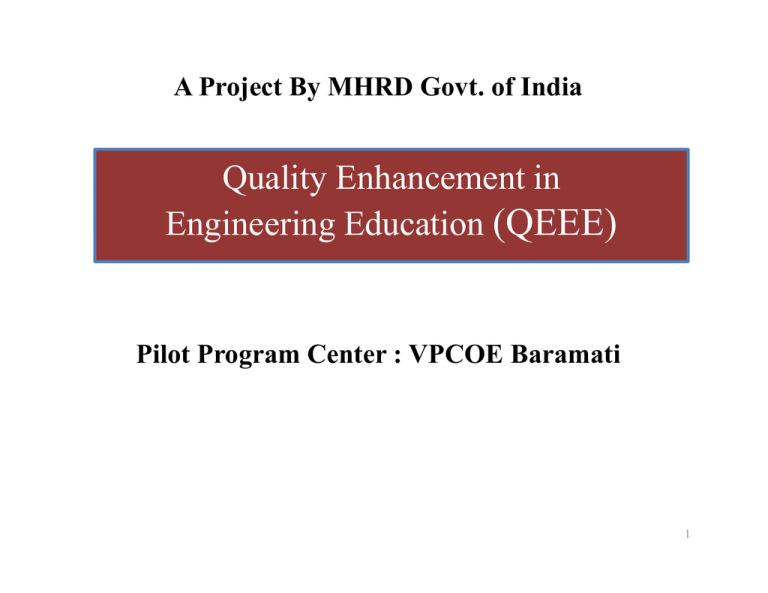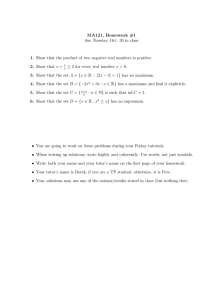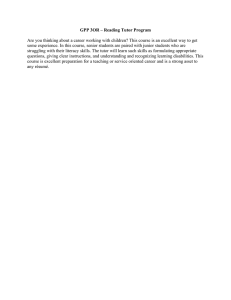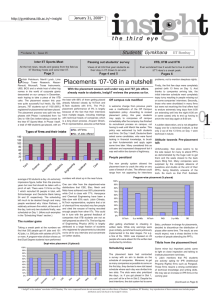(QEEE) Quality Enhancement in Engineering Education
advertisement

A Project By MHRD Govt. of India Quality Enhancement in Engineering Education (QEEE) Pilot Program Center : VPCOE Baramati 1 Reforms for Quality improvement in Technical Education • Concerted effort to enhance the quality of Indian engineering education and bridge the quantityquality gap through • Technological interventions • Empowering Teachers/educators • Suggesting policy reforms • To follow on a three pronged approach targeting students, faculty and managemen 3 Approach Direct to student Program Program on Teacher Training Policy Recommendations 4 The Direct to Student program • Goal: to utilise high quality pedagogical resources to enhance learning in a wider student community • Integration of top quality resources in the form of instructors and multimedia resources into followed curriculum and methods of teaching • Planned modules for this include Live classes, Tutorials, Virtual Labs, MOOCs and Vocational Augmentation Courses – to be delivered to 100 engineering colleges (mostly TEQUIP) in a pilot implementation form January 14 5 Program on Teacher Training • Tackling twin issues of faculty shortage and quality teacher-student interaction • Two approaches – Driving best UG students to become teachers of tomorrow • Encourage bright UG students to “Teach and Earn” you while studying and to provide them with top class training providing them attractive teaching cum research career – Five-level Continuous Teacher Training programs and Certifications over ten years 6 Teacher Training for 500 colleges • Teachers training in ‘teaching pedagogy’ as well as ‘specific subjects’ – mode of delivery to be a combination of in-person as well as technology-enabled – Workshops to be held for both kinds of training • Pedagogy training on technology enabled learning, verbal and written articulation abilities • Training on subjects through creation of training hubs to deliver training over vacations 7 Pilot from January 2014 for 100 selected colleges QEEE Direct to Students Program 9 Direct to Student Program • Integration of top quality scholastic inputs into current learning and teaching practices • Program modules include: • • • • • Live Classes Tutorials Virtual Labs Vocational Augmentation MOOC’s 10 Live Classes • Fifteen Live Classes for selected Courses for B.Tech.2nd, 4th and 6th semester – To be conducted by faculty members from IITM, IITB, IITD and IITK (selected from the list with highest ranking – in student feedback for three consecutive years at IITs) classes to projected in remote classrooms enabling all – students to learn simultaneously • Local teacher should be present in the class Two-way interactions between the course instructor and students/ local faculty • Rest of the course is to be handled by the local faculty 11 Tutorials • A model that enables an external tutor to provide remote tutorials to a small group of about 30 students – The tutor would be a senior student or a recently graduated person from industry • Tutors will be provided all material and trained – Sessions planned as problem solving classes – Increased scope for interaction and “camaraderie” between student and tutor promote a “mentoring” culture 12 Virtual Labs • Real lab experiment prototype made available to students based on content and resources sourced from IIT’s and other premier institutes – Students get to conduct experiments based on a set of prior instructions and loaded theory content – A remote tutor (in addition to local teacher) to assist in labs – 5 Labs have been shortlisted for the pilot program as follows: • • • • • Digital Signal Processing Lab, IITM Physical Sciences lab, Amritha University Electrical Machines Lab, IIT G Virtual Smart Structures and Dynamics Lab , IIT Delhi Micromachining Lab, COE Pune 13 Vocational Augmentation Courses • “Off curriculum” courses aimed at providing additional skills – Make students industry ready and improve employability • May be implemented as a classroom training program with live intervention by remote tutor —Wifi Security and Management (IITM), planned for the pilot is to implemented in this manner • Courses may also be designed as web based training — Courses for the pilot planned in this manner include • English for employment (BC) • SciLab (IITB) • GIMP (IITB) OSCAD (IITB) • 14 MOOC (Massive open online courses) • Courses are made available to learn via web: similar to the ones offered by MIT, Coursera • To be supplemented by online quizzes for students to master concepts and engage as a community as well • Three courses identified for the pilot 15 Program Delivery – The program will be delivered through, and accessed from a software platform created for this purpose – In addition to launching content, the platform will provide features for live intervention, and promote interaction between the remote teacher and students • • Whiteboard, screen share / document share etc. help simulate a classroom situation Video-chat, Q & A etc. promote interaction 17 Schematics of Delivery IGNOU Live lecture at IIT At the college Recording DTH dish Institute Server Set top box Cloud server At the IIT Moderator Laptop Classroom at Engg. college with two screens Tutorial :Schematics of Delivery At the college Institute Server Remote tutor A small batch of 30 students on LAN Students could log in from outside the institute as long as they have good connectivity Virtual Lab: Schematic of Delivery Local teacher Remote tutor Institute Server A batch of 60 students on LAN College 1 College 4 College 2 College 3 Students could log in from outside the institute as long as they have good connectivity Delivery plan • 25 hours of training – 5 saturdays, 5 hours per day • Local facilitators (senior students) to be indentified and sent to IITM for hands on training • Remote tutors identified, who will each be logged on to 5 colleges simultaneously. • t 31 THANK YOU









